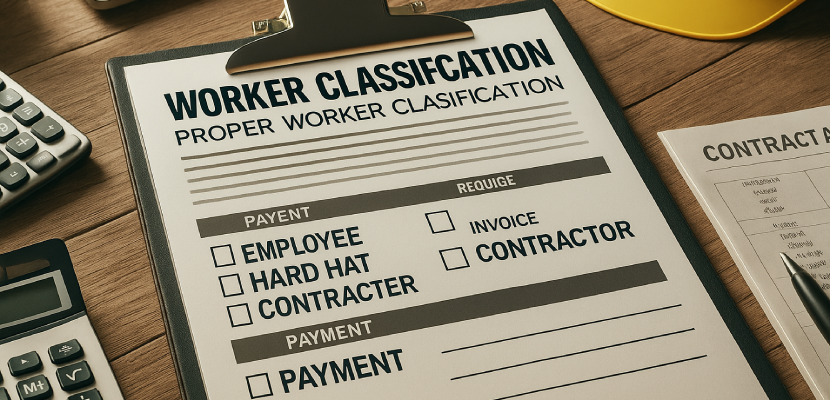|
|
Last Modified on Feb 25, 2025
Properly classifying construction workers is one of the most critical compliance responsibilities for employers in Minnesota. Misclassification can lead to severe financial penalties, back pay obligations, and increased scrutiny from state and federal agencies. To avoid these risks, construction companies must understand the difference between employees and independent contractors and ensure they follow the state’s 14-factor test for construction worker classification, which takes effect on March 1, 2025.
Why Proper Classification Matters
Misclassifying a worker as an independent contractor instead of an employee can expose your construction business to significant legal and financial consequences. Here’s why proper classification matters:
-
Legal Compliance: Minnesota’s new 14-factor classification test for construction workers is more stringent than past requirements. Failing to meet all 14 criteria could result in reclassification of workers as employees.
-
Financial Penalties: Misclassification can result in fines, back pay, and the repayment of benefits like unemployment insurance, workers’ compensation, and overtime.
-
Lawsuits and Claims: Misclassified workers may sue for unpaid wages, overtime, and benefits. In addition, government audits can lead to legal proceedings against your business.
-
Reputational Damage: Employers that face misclassification claims or penalties may suffer damage to their reputation, making it harder to attract skilled workers and clients.
Understanding the Difference: Employee vs. Independent Contractor
Employees and independent contractors have distinct roles within a business. An employee works under the control and direction of an employer, following the employer’s instructions on how, when, and where the work should be done. Employees are entitled to certain legal protections, such as minimum wage, overtime pay, unemployment benefits, workers’ compensation, and protection against discrimination. On the other hand, independent contractors operate as their own business entities. They have control over how and when they complete their work, often have multiple clients, and are responsible for their own business expenses, taxes, and insurance. Under Minnesota’s classification laws, workers are presumed to be employees unless the employer can prove otherwise by meeting the state’s 14-factor test.
Effective March 1, 2025, construction employers in Minnesota must meet all 14 factors to classify a worker as an independent contractor. This test is designed to ensure that independent contractors operate as true independent businesses. To qualify, the worker’s business must be independent, maintain its own tools and equipment, offer services to multiple clients, follow tax regulations, and have appropriate licenses and certifications. Additionally, the business must operate under a written contract, submit invoices under its business name, control the means and methods of the work, and bear the risk of profit or loss. If any of these factors are not met, the worker may be classified as an employee. This classification is stricter than previous standards, and employers must document and maintain evidence of compliance to avoid penalties.
Minnesota Construction Law Services keeps the simple simple
Consequences of Misclassification
If a construction worker is misclassified as an independent contractor when they should be classified as an employee, your business could face the following consequences:
-
Back Wages and Benefits: You may be required to pay back wages, unpaid overtime, and benefits like health insurance, paid leave, and retirement contributions.
-
Fines and Penalties: Government agencies like the Minnesota Department of Labor and Industry (DLI) and the Internal Revenue Service (IRS) may impose financial penalties.
-
Audits and Increased Scrutiny: Businesses that are found to have misclassified workers may be subject to future audits and stricter oversight.
-
Legal Claims and Lawsuits: Workers who feel they were misclassified may sue for back pay, unpaid overtime, and lost benefits.
How to Avoid Misclassification Penalties
To protect your construction business from costly fines and legal action, follow these best practices to ensure proper classification of workers:
-
Conduct a Self-Audit: Review your current worker classifications and apply the 14-factor test to ensure compliance. Identify any workers who may not meet all the criteria.
-
Use a Written Contract: Have a formal, signed contract with each independent contractor. The contract should specify key elements like payment terms, the scope of services, and who controls the work methods.
-
Confirm Worker Independence: Verify that the worker’s business is independent. This includes checking that the worker uses their own tools, works with multiple clients, and controls their own work schedule.
-
Maintain Documentation: Keep records of contracts, invoices, business registrations, licenses, and communications with the worker. Documentation can help you prove compliance in the event of an audit.
-
Train Your Management Team: Ensure managers, supervisors, and HR staff understand the 14-factor test and how to properly classify workers.
-
Seek Legal Guidance: When in doubt, consult with a construction law attorney. Legal counsel can help you review your classification practices and avoid misclassification penalties.
Get Help from Minnesota Construction Law Services
Worker classification is one of the most complex aspects of running a construction business in Minnesota. With the introduction of the 14-factor test for construction workers in 2025, it’s more important than ever to ensure your business is compliant.
If you’re unsure about your current worker classification practices or want to avoid costly penalties, reach out to the team at Minnesota Construction Law Services. Our experienced legal team can review your worker classifications, guide you through the 14-factor test, and help you avoid fines and lawsuits. Don’t wait until an audit or legal action arises — contact MNCLS today for proactive legal guidance.






